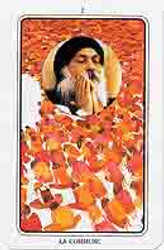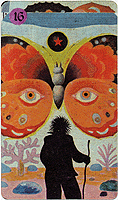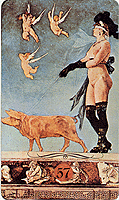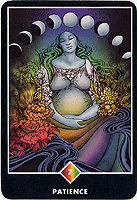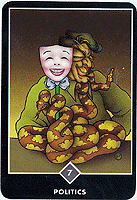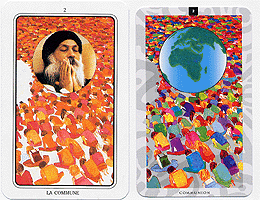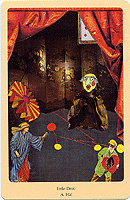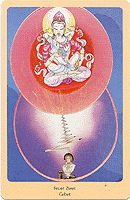From the Tarot Garden Archives: Osho and Tarot
Posted by Jeannette Roth on Jun 25th 2018
The article below, first published in 2002, was one of the more popular pieces from the Library section of the old Tarot Garden website. With renewed interest in the subject since the release of Netflix's documentary series Wild, Wild Country, we have moved it to our new site's blog, and updated the original text to reflect changes in the available information and location of relevant links.
From what wellspring does the inspiration for a tarot or cartomantic deck arise? Certainly anyone who has a hand in creating a set of cards for purposes of divination, meditation, or other enlightening use is influenced in their choice of structure and images by their personal experiences and beliefs. Indeed, is this not at least partly the point? To bring a new perspective to the cards? To add one's knowledge and unique voice to the compendium, and hope that the information may instruct and inspire others?
If we hope to gain insight from tarot in some manner, then it might be in our best interest to know who our "teacher" is: What motivated the creator to create his deck? What personal knowledge and experience do they wish to share? What does the creator hope that we can gain from his or her efforts? And perhaps, most importantly, what influences shaped the designer's perspective? Is the resulting work valid? Can it be trusted?
However, the intent of this article is not to answer any questions of validity. Rather, my intent is to explore a rather interesting set of influences that have made their mark on cartomantic cards over the last twenty years. But with luck, I'll be able provide you with some new information that will allow you to draw your own informed conclusions about a few well-known and well-loved decks.
The "influence" under discussion can be summed up in one word: Osho. The word is probably familiar to most tarot enthusiasts, but its significance may not be as well understood. So I'll begin with a little background information. For a more complete picture of the Osho organization, you may wish to check out some of the links at the end of this article.
Osho: Background
Osho might be best described as a "spiritual movement." According to information on the religioustolerance.org website, Osho's founder, Rajneesh Chandra Mohan, a.k.a. Acharya Rajneesh, a.k.a. Chandra Mohan Jain, "never subscribed to any religious faith during his lifetime." Originally a philosophy instructor at the University of Jabalpur, Rajneesh eventually changed his name to Bhagwan Shree Rajneesh and dedicated his life to teaching his disciples, called sannya, and to developing the organization devoted to promoting his spiritual philosophy. Originally referred to as the "Neo-Sannyas International Movement" or "Rajneeshism," the movement later adopted the name "Osho" shortly before its founder's death.
Rajneesh founded a commune in Poona, India in 1974. Eventually, amid controversy and personal health problems, he moved with a number of his disciples to the United States, and set up another commune near the town of Antelope, Oregon. In the U.S., Rajneeshism's numbers swelled, perhaps because the Bhagwan offered advice on achieving spiritual enlightenment without simultaneously advocating the rejection of materialism that typically accompanies Eastern spiritual philosophies. By all accounts, Rajneesh was a highly charismatic leader, and the meditative techniques he developed were reported to have been highly effective. He drew from an eclectic mixture of the world's great religions, and strongly eschewed racism, sexism, or intolerance of any sort. Whether Rajneesh and his followers practiced what they preached has been debated by some, but there is no question that open-mindedness is a highly-valued ethic in their core philosophy.
By the mid-1980s, the tensions between the expanding commune and the residents of nearby Antelope produced disastrous results. Several of the commune members were charged with, and later convicted of, numerous criminal acts, including conspiracy and attempted murder. The motives of the sannya involved appeared to include an attempt to control local elections. How much knowledge the Bhagwan had of his disciples' activities in these regards, or whether he had a hand in any such unsavory undertakings himself, remains a matter of debate. The Bhagwan publicly repudiated the actions of his accused followers, but was eventually deported from the U.S. a few years later. He returned to Poona, and eventually changed his name to Osho -- the name by which the movement he began is now known. Osho died in 1990, the victim of extensive health problems, but the Osho organization lives on through Rajneesh's extensive writings, and through its approximately 20 meditation centers established throughout the world.
The history of Osho, the evolution of his philosophy, his followers, and the Osho movement is far more interesting and colorful than the brief overview I've presented here. But I've attempted to confine myself to the facts. Osho and his organization have inspired both great enthusiasm and great scorn, and as I said at the outset, my intent is to examine influences -- not to pass judgment. I encourage all readers to check out the links provided at the end of this article for more information, and to subsequently determine the true nature of Osho for themselves.
Osho and Cartomancy
So -- what does all this have to do with tarot? Plenty. First and foremost, it might arguably be said that followers of Osho have produced and published more original cartomantic decks than any other non-pagan spiritual discipline. [Author's Note: In the sixteen intervening years since this article's initial publication, it is possible that the preceding statement may now be inaccurate.] Second, the emphasis on meditation within the Osho philosophy is clearly reflected in the decks produced by its members; this emphasis may have subsequently had some effect on the growing acceptance of tarot as an effective meditational tool.
To date, I've been able to locate six different Osho-influenced cartomantic decks which have received some reasonable measure of distribution -- or at least notoriety. One of the decks has recently undergone some changes, so that like the Rajneeshism/Osho movement itself, it is known by several different names. What follows is a look at a few of the better-known Osho decks, and what can be said about their design and purpose in light of the Osho connection.
The Goose is Out
This 108-card deck, published in 1982, was described by creators Swami Veet Bruco and Ma Prem Jagruti as "a meeting between Tarot and Poker." In fact, the deck bears no resemblance at all, structurally or image-wise, to either a traditional tarot or a standard poker deck. Instead, the card pictures are as eclectic as Rajneesh's philosophy itself, and include traditional Middle Eastern art, colorized Victorian-age engravings, details from the works of famous artists from Boticelli to Escher, simple cartoons, and more. The complete lack of structure or pictorial consistency might frustrate some readers, but that, according to the accompanying book, is precisely the point. The designers had this to say about the use of tarot:
We played and played with Tarots, with different decks, with the 'Rider-Waite,' and changed over the Crowley's [sic] 'Thoth-deck' and to the tantric 'Dakini' but they all kept us on the floor -- no way to fly. Now we try to take off: let the geese out!
The only one who was able to take the jump, this quantum leap from the old traditional deck into the new Tarot was THE FOOL. He was standing too long there near the abyss... Now he just jumped down, spread his wings and started flying with the geese. With this he left all the seriousness of the old games behind him. Having a look backwards to all these Kings and Queens: they look just like dead marionettes, sitting in their Arcanas like in dusty picture-galleries surrounded by their swords and wands.
Now the Fool has become a child again, fooling and playing around, discovering for the first time music and dance, celebration of life. Not following any prefabricated path, the Fool goes from one meeting to the next. Where he expected to meet the 'Emperor' of the Kingdom of the cards -- a quite arteriosclerotic old guy -- he finds an ordinary man. He is naked but in his way of moving he seems to be a real Aristocrat, a king of life. He looks like a Greek God, coming out of the forgetfulness of men, big in an endless sky. In him all the Masters become alive again, Jesus, Buddha, Lao Tzu... In this moment the Fool becomes aware of his own real nature. He looks down along his body and with utter astonishment he realizes his own grace. He has become a Prince.
The inclusion of the "Goose" tarot in Stuart Kaplan's Encyclopedia of Tarot, vol. III may arguably be credited with saving this odd collection of images from relative obscurity. Thanks to Kaplan, Bruco and Jagruti's deck is often much sought-after by collectors, and has been known to bring prices of up to $1,000 for a single copy. One might view this eclectic compilation as highly disconcerting and too chaotic to be useful -- or as being unconventional, playful, and refreshingly free of pretensions. And either way, you might be right.
Osho Zen Tarot
This is probably the best-known Osho tarot... in fact, it may be one of the best-known tarots ever produced. First published in 1994 in Great Britain by Boxtree Ltd., and picked up for republication and global distribution shortly thereafter by St. Martin's Press, the Osho Zen has remained one of the all-time best-selling tarots ever since.
Unlike The Goose is Out deck, the Osho Zen retains most of the structure of a traditional tarot -- although creator Ma Deva Padma has eschewed the use of the normal suit designations in favor of colors aligned with the cards' elemental properties. The card titles or key words, while not common or "traditional," are not far afield of the general qualities assigned to the cards themselves by the Golden Dawn system that underlies the Rider-Waite deck.
There is also, not surprisingly, an extra, unnumbered Major Arcana card entitled "The Master," which bears the image of Rajneesh himself. This twenty-third card has a special significance in the Osho approach to tarot's teaching. According to the text:
In the traditional tarot deck this journey of self-discovery was perceived as a kind of spiral, with each Completion leading to a new level on the path, a new beginning with the reentry of The Fool. In this deck, however, the Master card has been added. This card allows us to leave the spiral behind, to take a jump off the wheel of death and rebirth.
As to the use of the deck for divinatory purposes, the text continues on to say:
Osho Zen Tarot is definitely not a traditional tarot in the sense that you play with prediction. Rather it is a transcendental game of Zen which mirrors the moment, unwaveringly presenting what is here, now, without judgment or comparison. This game is a wake-up call to tune in to sensitivity, intuition, compassion, receptivity, courage, and individuality... This focus on awareness is one of the many innovations to the old systems and thinking of the tarot that will soon become obvious to experienced users as they begin to work with the Osho Zen Tarot.
The images of the Osho Zen deck are colorful and peaceful, and show an obvious Eastern influence. Whereas The Goose is Out is full of unbridled energy designed to turn one's viewpoint topsy-turvy, the Osho Zen is contrastingly calm and focused -- a vehicle for channeling heretofore unleashed energy into useful purposes.
Rajneesh Neo Tarot / Osho Transformation Tarot
Once again, despite the use of the word "Tarot," this deck has little in common with a standard tarot, other than being a set of cards that can be used as a tool for cartomancy, meditation, and/or spiritual growth. It contains a total of 60 cards, designed for both personal readings and for meditation. Each card contains a Zen-like title, such as "Light on the Path" or "Ultimate Accident."
In the Rajneesh variant of this deck, the first two cards contain photographs of Rajneesh himself. This version of the deck was distributed in a number of European markets under a title which translated to Tarot of the Rajneesh. In North America, the deck was variously distributed under the name Rajneesh Neo Tarot and Osho Neo Tarot.
In the Osho Transformation Tarot, the first two cards have been replaced with illustrations in the style of the rest of the deck. The general theme of the cards -- entitled "No Mind" and "Communion" in English -- remains the same as in the Rajneesh edition. In addition, the plain white backgrounds of the Rajneesh deck have been replaced with a more stylized, less "stark" abstract pattern in shades of gray. Again we find St. Martin's Press as the publisher of the revised edition, with copies made available on the international market in several languages. The St. Martin's edition, and some of the Rajneesh editions, also include a book that provides a story-parable for each card -- a potentially useful addition to the deck for meditative purposes.
Comparison of the "Communion" card
From the Tarot de Rajneesh (left) and
Osho Transformation Tarot (right)
The illustrations by Pujan Waduda are stylistically more simple than those of Padma's Osho Zen deck, and generally exhibit more of a Japanese flavor than an Indian one -- although the inspirations for the images themselves are drawn from a variety of cultural sources.
Although much less tarot-like than the Osho Zen, the Osho Transformation book ironically provides more concrete instructions for how the deck might be used for divination and meditational purposes.
Il Sentiero del Reale and Il Sentiero dell'Essere
These two decks, published by Lo Scarabeo and both out-of-print, each consist of 56 cards. I was unable to obtain review copies of these decks, although the Reale deck appears to have a Tantric theme, while the Essere deck looks as if it may be more focused on chakras and Eastern meditation techniques.
Flying Hearts Tarot
Only one step removed from the Osho-acknowledging tarots is a 1988 deck entitled Flying Hearts Tarot (Lachend das Leben Spielen). This collaborative collage deck was compiled by The Flying Hearts Company. who, according to an article by tarot authority K. Frank Jensen in issue #1 of his Manteia newsletter, is "a group of (former?) Raineesh-people [sic]... The deck is much in the style with The Goose is Out... (some people might even be the same, if I remember right)."
And indeed, in the Flying Hearts Tarot, we see much of the same playfulness and irreverence that characterize The Goose is Out cards. Like the Goose deck, some of the pictures are elongated and are therefore printed sideways on the cards. The deck was published in Germany, and the accompanying book text is, as expected, in German. But according to Jensen's article, the authors exhort the reader once again to abandon any preconceived notions about the cards and their use:
...a great part of the text are poems or meditations relating to each of the cards in the deck. Like the introduction to the chapter on how to use the deck says: 'The only rule for using the tarot is, that there are no such rules. The players themselves decide the rules.
In contrast to the Goose deck, the Flying Hearts tarot does follow a more-or-less standard 78-card tarot structure -- although the creators opted, as Padma did later, to represent the suits by their elemental attributions, rather than using the more common Marseilles or Waite symbols. Nonetheless, with its images of tuxedoed, martini-drinking Buddhas and copulating frogs, the deck was clearly designed to repudiate established conventions -- not to embrace them. The titles adopted for the Minor Arcana cards are highly nontraditional, but could arguably be said to follow the general concepts put forth by Waite and those of the Golden Dawn tradition.
Conclusion
Although the Osho group itself has a colorful and controversial history, its contributions to and influence within the world of cartomantic decks cannot be denied. The Osho wellspring from which these decks arise is evident in the emphasis on their meditative aspects. In addition, the decks appear to be generally less reliant, to a greater or lesser degree, on traditional structure and convention.
Past scandals and an increasing emphasis on commercialism may taint the perception of these cards for some, but for others, their usefulness and positive benefits may be the true test of the Osho decks' validity and worth. But as always, the final analysis of the Osho tarots is -- as they say -- left as an exercise for the reader.
17 April 2002
Related Links:
Osho.com. Official website of Osho products and services.
sannyas.wiki (formerly Osho: Never Born Never Died). Wiki archive maintained by adherents of the Osho spiritual system; includes a tremendous number of documents and numerous links to articles, writings, and pictures pertaining to Osho.
Osho, by Religioustolerance.org. A summary of the man and the movement by the Ontario Center for Religious Tolerance.
The Enigmatic "Bhagwan", Osho Rajneesh. A more critical appraisal of Osho's impact as a spiritual counselor and leader.
Osho, Bhagwan Rajneesh, and the Lost Truth. An interesting analysis of Rajneesh's strengths and failings, in a historical perspective, by a former Osho sannyasin.
Bitterness Endures at Rancho Rajneesh. Article from The Seattle-Times about the scandal at the Oregon commune, its aftermath, and the long-term effects on the local community.
Bhagwan's Club Meditation. A 1994 Washington Post article about the genesis of the Osho organization after the death of the Rajneesh.
Old Bhagwan, New Bottles. A more blatantly critical commentary, published in 1999, on the Osho group's activities since the Rajneesh's death.

